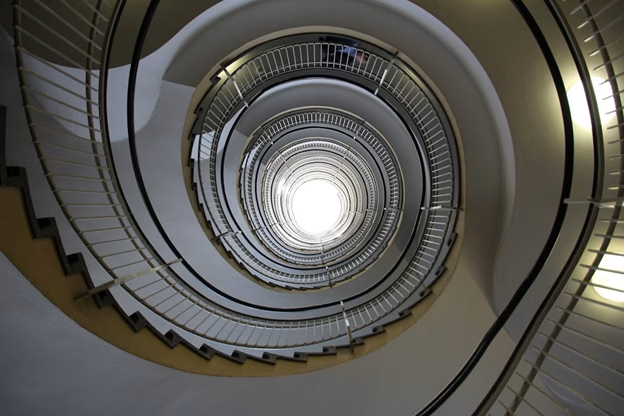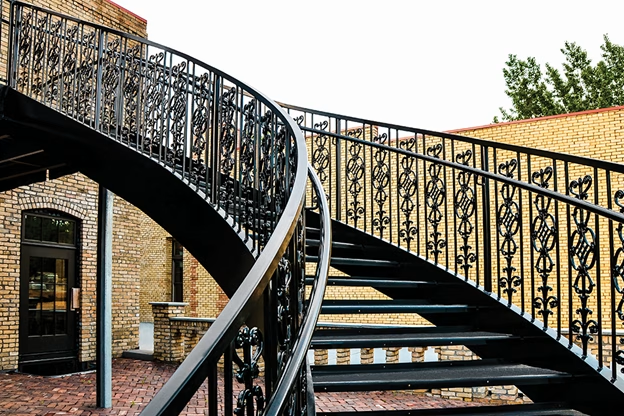Staircases have always been architectural focal points, commanding attention not only for their functionality but also for their artistry. When it comes to curved, spiral, or multi-bend staircases, the challenge is amplified. These staircases present unique geometrical complexities that demand careful consideration, especially in designing architectural railings. A railing is more than a safety feature; it is an essential design element that enhances flow, proportion, and structural integrity.
In this article, we’ll explore the nuances of designing railings for curved and complex staircases, focusing on material selection, engineering challenges, and construction precision to ensure both safety and aesthetic appeal.
The Challenge of Geometry
Unlike straight flights of stairs, curved and spiral staircases feature continuously changing angles, radii, and slopes. This creates three primary challenges in railing design:
- Alignment and Consistency – The railing must follow the curve seamlessly without abrupt transitions that could compromise both safety and design.
- Load Distribution – Stair users often apply significant force to the railing, especially on spirals where the turn is tighter. Ensuring even load transfer to the supporting structure is critical.
- Visual Harmony – The railing must enhance, not interrupt, the natural flow of the design. A mismatched or rigid system can diminish the elegance of the staircase.
Material Selection: Balancing Flexibility and Strength
The choice of material greatly influences the success of a railing system on a complex staircase. Some materials are naturally suited for bending and curving, while others require advanced fabrication methods.
1. Metal Railings
Metals like steel, stainless steel, and aluminum are versatile options. They can be rolled, welded, or fabricated to match the exact curve of the staircase. Stainless steel, in particular, is favored for its durability and sleek modern aesthetic. Powder-coated steel provides additional customization in color and texture, making it adaptable to both residential and commercial settings.
2. Cable Railings
Cable systems are a popular solution for curved staircases due to their flexibility. Tensioned cables can follow the staircase’s changing trajectory without requiring extensive shaping. Paired with metal or wooden posts, cable railings create a minimal, contemporary look while maintaining safety and code compliance.
3. Glass Railings
For staircases designed to showcase openness and light, glass panels offer unmatched transparency. However, achieving curvature with glass requires precise tempering and lamination. Curved glass panels are custom-fabricated, making them more costly but highly impactful in high-end designs. They pair well with metal or wood handrails to soften the rigidity of the material.
4. Wood Railings
Wood remains a timeless choice, especially in traditional or transitional spaces. Modern milling techniques allow wood to be bent or laminated into curved shapes. Wood provides warmth and tactile comfort, though it requires expert craftsmanship to ensure durability along complex geometries.

Precision in Construction
Even with the right materials, the success of a railing system lies in execution. Precision at every stage from digital modeling to on-site installation ensures the final product meets both safety standards and design intent.
1. Digital Modeling and Templates
Advances in 3D modeling software allow architects and fabricators to map the exact curve of a staircase before cutting a single piece of material. Laser scanning can capture site conditions with millimeter accuracy, creating digital templates that reduce errors during fabrication.
2. Fabrication Techniques
- Cold and Hot Bending: Metals can be shaped using rollers or heat, depending on thickness and material properties.
- Lamination: Wood or glass can be built up in layers, glued, and pressed into curved forms.
- Pre-Tensioning: For cable systems, precision in tensioning ensures cables do not sag or compromise safety on the curve.
3. Installation Precision
On-site installation requires skilled tradespeople who understand how to translate digital plans into real-world results. Anchoring posts into curved surfaces or aligning glass panels along a spiral demands careful adjustment. Tolerances are often tighter than in straight staircases, since even small misalignments can disrupt the visual flow.
Safety Considerations
While aesthetics and craftsmanship are crucial, safety remains the top priority in railing design. For curved and complex staircases, this involves:
- Code Compliance: Meeting minimum height, spacing, and load-bearing requirements as specified by local building codes.
- Handrail Continuity: Ensuring the handrail provides uninterrupted support along the curve, without gaps or uncomfortable transitions.
- Non-Slip Finishes: Especially for metal or glass railings, surface finishes should prevent slips or loss of grip.
- Durability: Materials and connections must withstand wear, environmental conditions, and repeated stress over time.
Design Integrity: Beyond Functionality
Curved staircases are often centerpieces of a building, whether in a grand hotel lobby, a corporate atrium, or a residential home. The railing should amplify the drama of the staircase without overwhelming it. A well-designed system achieves:
- Flow: The handrail follows the curve effortlessly, creating a sense of movement.
- Balance: Material choice complements the surrounding architecture. For example, glass in modern settings or wood in traditional spaces.
- Transparency vs. Solidity: Depending on the desired effect, the railing can either accentuate openness (with glass or cable) or provide a solid sculptural presence (with metal or wood).
Conclusion
Designing railings for curved and complex staircases is a blend of art, engineering, and precision craftsmanship. It requires an understanding of geometry, a strategic choice of materials, and an unwavering commitment to detail during fabrication and installation. The reward is a railing system that not only ensures safety but also elevates the architectural experience.
In the end, the railing should feel like a natural extension of the staircase guiding, protecting, and enhancing its form. With thoughtful design and execution, even the trickiest geometries can be transformed into breathtaking architectural statements.

